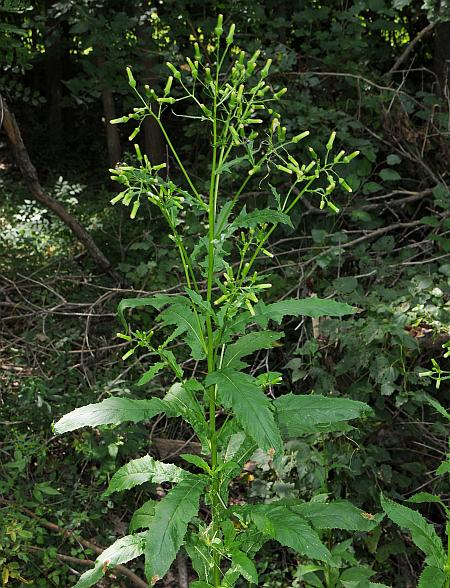Erechtites hieraciifolius (L.) Raf. ex DC.
Fireweed, Pilewort

Native
CC = 1
CW = 5
MOC = 63
© SRTurner
Erechtites hieraciifolius (L.) Raf. ex DC.Fireweed, Pilewort | |
 |
Native CC = 1 CW = 5 MOC = 63 |
© SRTurner |
|
Family - Asteraceae/Senecioneae Habit - Taprooted annual forb. Stems - Strongly ascending to erect, to 2.5 m, usually unbranched below the inflorescence, lined and/or angled, glabrous to moderately pubescent with more or less spreading hairs.
Leaves - Basal and alternate, reduced in size upward, glabrous to moderately hairy, at least on the undersurface. Basal and lowermost stem leaves mostly short-petiolate, the blades simple, 3-20 cm long, elliptic to narrowly ovate, tapered to a sharply pointed tip, occasionally irregularly and shallowly pinnately lobed, the base tapered to the petiole, the margins sharply toothed, the venation pinnate. Median and upper leaves narrower with progressively shorter petioles and usually deeper lobes, sometimes sessile and with clasping bases, the very uppermost leaves often narrowly elliptic-lanceolate.
Inflorescence - Terminal and axillary panicles from the uppermost leaves, elongate to rounded in profile.
Heads - Discoid, short- to long-stalked, mostly with 20-45 florets. Involucre 10-17 mm long, cylindrical above a somewhat swollen, disclike base, the bracts in 2 series, usually glabrous, the inner series of 9-15 bracts, these relatively flat dorsally and uniformly green; the outer series of 4-7 bracts, these minute, ascending, and incurved, uniformly green.
Florets - Ray florets absent. Disk florets with corollas 7-13 mm long, pale cream-colored. Style branches with a stigmatic line along each inner margin. Fruits - Achenes 2-3 mm long, more or less linear in outline, not flattened, 10-12-ribbed, glabrous, light brown.
Flowering - July - November. Habitat - Rocky open woods, eroded slopes, thickets, waste ground, disturbed sites, fields, roadsides, railroads. Origin - Native to the U.S. Lookalikes - Senecio vulgaris. Other info. - This tall and easily identifiable species is common throughout Missouri and the eastern half of the continental U.S., also ranging into Canada, Mexico, and Central America. The plant is a pioneer, one of the first species to become established after a soil disturbance or fire. It is fast-growing and can reach a height of 3m, although it can also flower when quite small, especially if it is mowed or is growing in an area with poor soil. Photographs taken in Brown Summit, NC., 7-12-02 (DETenaglia); also near Labadie, Franklin County, MO, 09-29-2008, at Pickle Springs Natural Area, Ste. Genevieve County, MO, 09-19-2009, at LaBarque Creek Conservation Area, Jefferson County, MO, 9-24-2014, Tyson County Park, St. Louis County, MO, 08-31-2018, Riverfront Park, Washington, Franklin County, MO, 9-15-2018, Don Robinson State Park, Jefferson County, MO, 9-19-2021 (SRTurner). |